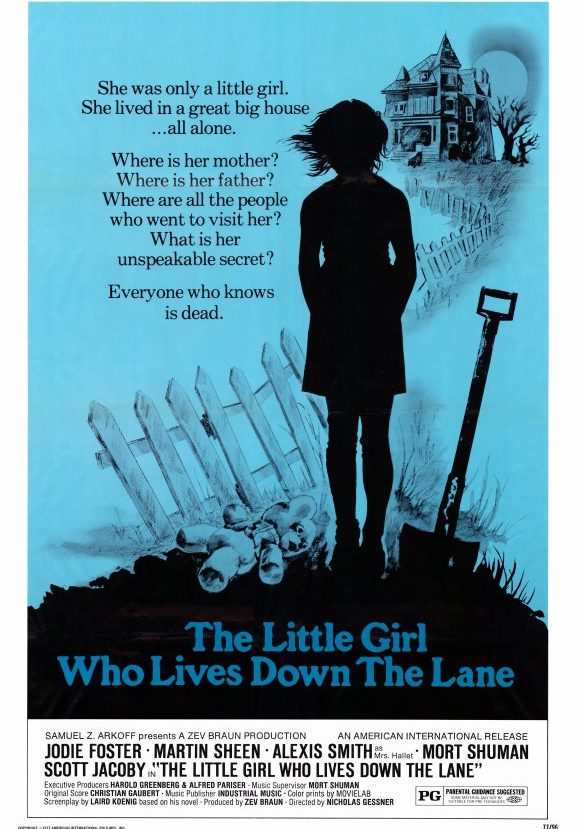A Chilling Solitude: “The Little Girl Who Lives Down the Lane”
“I think being alone is very important,” whispers young Rynn Jacobs in the quiet, seaside town setting of “The Little Girl Who Lives Down the Lane.” Directed by Nicolas Gessner and released in 1976, this film weaves an intricate tapestry of suspense and horror that belies the innocent facade of its young protagonist. Rynn (played by Jodie Foster) is a 13-year-old girl of enigmatic solitude, whose reclusive lifestyle raises eyebrows and suspicions in a small community. When various townsfolk, each with their own dark motives, attempt to pierce her veil of secrecy, they are met with an unsettling resistance that calls into question the nature of innocence itself.
The Creeping Shadows of Dread
The horror of “The Little Girl Who Lives Down the Lane” is not a product of monstrous entities or splattering gore but rather the creeping shadows of dread that linger in the corners of the mundane. Gessner expertly crafts an atmosphere heavy with foreboding, utilizing the slow burn of suspense to engage the audience. Much of the film’s tension is derived not from what is seen, but what is suggested, leaving viewers to fill the silent spaces with their own imaginations. The cinematography, minimalistic yet haunting, relies on dim lighting and the stark austerity of Rynn’s home to foster a sense of isolation and concealment. The camera angles are intimate and often claustrophobic, enhancing the viewer’s connection to Rynn’s eerie existence.
The soundtrack, sparse and eerily composed, perfectly underscores the film’s tone. The clever use of silence punctuates the narrative, allowing the actors’ performances and the natural sounds of the setting to create an authentic experience that chilled contemporary audiences and continues to do so decades later.
The Faces of Innocence and Menace
Rynn Jacobs, as brought to life by Foster, is the film’s enigmatic core—a portrayal that combines youthful naiveté with an unsettling maturity. Foster’s performance is both captivating and chilling, pulling the audience into her world of secrets with a maturity beyond her years. The small, yet impactful, cast complements her with equally compelling performances. Martin Sheen’s portrayal of the creepy Frank Hallet adds a skin-crawling presence and nuance to the piece, making for an excellent foil to Rynn’s character.
What makes the characters resonate is their development and the believable reactions to the burgeoning horrors presented. There is a sense of genuine peril in their interactions, with each actor contributing to a growing feeling of dread that clings to the narrative like a second skin.
Whispering Horror: The Subtleties of Fear
The horror elements in “The Little Girl Who Lives Down the Lane” lie predominantly in the psychological realm, with the film challenging many conventions of the genre. Rather than relying on jump scares or visceral terror, the narrative builds a psychological maze that leads viewers to question the nature of the threat itself. The film plays with ambiguity, keeping audiences guessing about the true extent of the darkness within.
Underneath the chilling storyline, the film is rife with thematic depth, exploring issues like autonomy, the corruption of innocence, and the perils of adulthood imposed upon childhood. It is in this weaving of social commentary with suspense that the movie finds its enduring impact, one that leaves viewers mulling over the implications long after the final credits roll.
As a horror movie, “The Little Girl Who Lives Down the Lane” stands as an example of how tension and atmosphere can induce fear without graphic imagery or supernatural tropes. Its capacity to haunt lies in the psychological manipulation of safety and normalcy, rendering it a thought-provoking piece for those who appreciate a more cerebral approach to the genre.
Fans of slow-burning, atmospheric horror akin to “Rosemary’s Baby” or “The Sixth Sense” will find “The Little Girl Who Lives Down the Lane” a satisfying exploration into the psyche’s darker recesses. While this movie isn’t for the gore-hungry crowd, it will appeal to those who revel in the subtleties of storytelling and the puzzles of the human condition.
In Whispered Echoes: Final Verdict
Despite its age, “The Little Girl Who Lives Down the Lane” remains a potent entry in the horror canon, notable for its psychological depth and the formidable performance of a young Jodie Foster. Its strengths lie in restraint, sinister subtlety, and thematic richness, though some might find its pacing and subtleties less impactful in an era dominated by high-intensity horror. Nonetheless, it remains a recommended watch for those seeking chills spawned from the quiet echoes of a small-town mystery and the unsettling poise of a little girl who knows too much.
For the contemporary viewer, this film is a reminder that true horror often whispers from the shadows of ordinary lives. With its capacity to unsettle without explicit content, “The Little Girl Who Lives Down the Lane” may be suitable for a wider audience, though caution is advised due to some themes and scenes that might be distressing.




